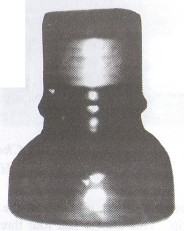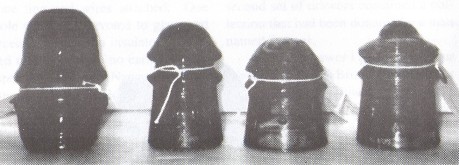Insulators at the Smithsonian Institution
by Gus Stafford
Reprinted from "Crown Jewels of the Wire", October 1993, page 17
I first visited the Smithsonian Institution Museum, Washington, D.C., in
search of insulators in 1991. I found a total of fourteen insulators in three
separate museum buildings. Of these fourteen insulators, only three were
noteworthy. In a telegraph display in the old Smithsonian Castle, there was a CD
123 EC&M, a CD 1038 coffin base Cutter, and a CD 1000 glass block, all in
aqua.
Over the next two years, I spent many hours going through the different
Smithsonian museums. After viewing the expansive collections of other items of
American history, I began to wonder if there were more insulators packed away in
the museum archives. I called the National Museum of American History,
Department of Electricity and Modem Physics, in search of more information. I
was informed that there were more insulators available for viewing in the
Research Division. I made an appointment for the following week.
My guide for
the trip was the Research Collection Manager, Nance Briscoe. It turned out that
one of her sons had also collected insulators, so she naturally understood my
curiosity. She took me upstairs in the National Museum of American History to
the caged room which housed the research collection.
The collection was stored in
a long rectangular room with floor to ceiling shelves organized in stacks not
unlike the research area of a public library. The shelves contained everything
imaginable having to do with electricity and modem physics, from Ben Franklin's
experimental devices, through the inventions of Edison and Bell to the pocket
calculators and laser disc players. Many of the items were one-of-a-kind, patent
models, or items of historical importance. Nance Briscoe not only catalogs and
researches the collection, but also repairs, restores, and maintains these
important links in the chains of American history. And you thought keeping track
of your insulator collection was tough!
Nance told me that before I could look
at the insulators, I had to look at the rest of the inventions and devices
stored in the research collection. Needless to say, it was like trying to drink
water from a firehouse!! We made our way chronologically through telegraph keys,
phones and fiber optics. About twenty minutes into the tour, Nance told me that
we were almost to the insulators.

Two wood covered Wades |

CD 1000 glass block in a wooden
"roof-cover" side mount |
I looked at the shelf on my left and responded, "I think we're already
there'"
On the shelf to my left were three items; two Wades with perfect
wood covers complete with sidepins and a CD 1000 glass block still in its wooden
side mount! I wrote down the reference numbers for these beauties, and with
Nance's help found that they had been donated to the museum by "an
insulator collector" in the late 1800's'!!
The next set of shelves yielded
a pair of royal purple CD 102 B.T.C. of Can/Diamond ponies complete with phone
line and wires attached. One whole shelf was devoted to glass and porcelain
suspension insulators. I noticed that there were no carnival glass suspensions
and asked Nance about their absence. She explained that her department had not
sought to obtain one of every type of insulator, merely representative samples
of the field. This made sense given the limited about of storage space available
to the Electricity and Modem Physics Department. As an example of excessive, one
specialized area Nance Briscoe showed me was a vacuum tube collection that had
been donated by a collector. The wooden, glass enclosed cases with their
infinite array of TV, radio and communication tubes were beautiful to look at,
but they took up the better part of an entire wall in the research collection.
The actual insulator collection itself was stored in large wooden drawers at the
end of the room and was divided into two sections. The first set of drawers
contained insulators which had arrived piecemeal over the years. The second set
of drawers contained a collection that had been donated by a man named Sawyer.
The first drawer I opened had four Wades and three Brooke's ramshorns along with
various white porcelain spools used in household wiring. The condition of these
pieces would lead one to believe that they had been salvaged from historical
digs or demolitions of old structures.

Two CD 735 Chesters flank a carnival CD 118 and an H.K. Porter on the right.
A couple of drawers later I came upon the
threadless insulators and my second favorite insulator of the entire trip. This drawer had four threadless
insulators, an H.K Porter plastic replacement (how did that get there?) and a
carnival glass CD 118. There were two aqua CD 735 U.S. TEL./CHESTER, one mint
and one near mint, a shellaced wooden/composition hat, and the
"beauty" -- a VNM (Skirt crack) CD735.6 "Big Blue." The label
affixed to this insulator was yellowed with age and stated that the insulator
had come off the side of a house in the late 1800's! But I said that this was my
second favorite insulator, I found my favorite in the next drawer!
As I pulled
open the next drawer, a cobalt CD 123 E.C.&M. and an aqua CD 130 Ca!. Elec.
Works came into
view. I pulled a little further and saw cobalt again, but his time it was a
dead mint CD 140.5 cobalt blob! As I looked at this beauty, I realized that I
was having the opportunity to handle an insulator that few of us ever get to see
let alone touch. The rest of the drawer was anticlimactic; another cobalt CD 123
EC&M, an aqua CD 110.5 National and an aqua CD 136.7 Pat. Oct. 15, 1872 with
three segmented threads.

A cobalt CD 123 E.C.&M., CD 136.7 in aqua, CD140.5 cobalt
"blob",
a wooden/composition "hat" and CD 110.5 corkscrew.
This was the last drawer of the piecemeal portion of
the collection. The Sawyer collection contained general telephone and telegraph
insulators in the common to collectable range. As a novice collector, I was
fascinated by every insulator I saw, but I won't bore you with the details.
There was only one threadless insulator, a CD 732 no name in dark amber that was missing
two-thirds of its skirt.

"Big Blue's" label indicated it came off
the side of a house in
the 1800's.
As we finished up I asked Nance about donations. There
were, for example, no power piece or porcelain and many common shaped and
manufacturers missing as well. She reminded me again about the
"representative" nature of the collection and the problems with
storage. She also stated that she is interested in the research that collectors
have done, and would welcome information to augment their research files. Her
address, should anyone like to help preserve information concerning insulators,
lightning rod balls, etc. is:
Nance L. Briscoe
Collection Manager
Division of Electricity and Modem Physics
National Museum of American History
Smithsonian Institution
Washington, D.C.
20560
(202) 357-1840
One final note...as I was leaving, I commented to Nance that I had been
through all of the museums in the Smithsonian looking for insulators. She asked
me if I had been to the new hands-on exhibit in the National Museum of American
History. I told her that I had not, and she led me downstairs.
In the telegraph
hands-on area was a reconstruction of an old telegraph pole with two cross arms.
"What was on it?", you ask. Only a mint CD 737 Lefferts, two Brooke's
ramshorns, two cobalt CD 123 EC&Ms, an aqua CD 131 Brookfield and a purple
CD 121 W.G.M. CO.!

Several other items in the general collection: CD 732 in blackglass
and CD
106 Lynchburg in olive green; CD 102.3 Dot, Dot in aqua and
a CD 106.1 Duquesne
in cornflower blue.
| 

































































